estudo de caso: mimoSa
(escrito em 6 de maio de 2006 para o site http://turbulence.org)
english below
o que é mimoSa?
mimoSa são oficinas para a construção de uma máquina de intervenção urbana e correção informacional, ou uma mídia móvel (S.A.). Mais que isso, mimoSa é também a máquina construída durante essas oficinas, onde o objeto máquina personifica-se, humaniza-se, grava histórias locais e as publica na internet. baseada nos trabalhos de Ricardo Zuniga [1] (que possuia uma radio movel dentro de um carrinho de supermercado, que percorria ruas de nova iorque – eua), Neurotransmiter [2] (que fazem transmissao FM em baixa frequencia com equipamento portatil, como uma mochila), murmur toronto [3] (que grava historias locais da cidade de toronto no canada e as disponibiliza via internet um um mapa geografico da cidade) e utilizando como metodologia para as oficinas a MetaReciclagem [4], as oficinas mimoSa possuem dois objetivos que se tornaram claros no decorrer das oficinas que aconteceram ateh aqui: 1.) construir uma maquina movel que seja capaz de gravar depoimentos de pessoas e 2.) produzir intervencoes urbanas para a gravacao dessas historias. as oficinas de metareciclagem para a producao do objeto, buscam utilizar-se de equipamento tecnologico dito obsoleto (computadores antigos, motores de utensilios domesticos, carrinhos de feira, cadeiras giratorias) para a producao de um outro bem tecno-estético. Porem, o que difere a maquina mimoSa dos objetos utilizados para sua construcao eh, a resignificacao dada a eles. Alem disso, por ser uma nova maquina, com um nome que no brasil pode ser utilizado para varias coisas (tanto para chamar vacas [eh comum em criacoes de gado de pequeno porte encontrarmos vacas chamadas de mimosas] como para identificar algo como carinhoso, meigo, mimoso... eh tambem o nome dado a uma regiao da cidade do rio de janeiro sabidamente dedicada a prostituicao feminina) e, principalmente, por ser montada durante oficinas com uma media de 8 a 12 pessoas, que participam das mais diversas formas (construindo estrutura, instalando softwares, recortando fios, remontando computadores, executando intervencoes urbanas), mimoSa ganha vida, adquirindo expressoes pessoais em um trabalho coletiva, e não raro, comentários como “mimoSa tambem é gente” ou “coitadinha, não pode continuar dormindo na garagem” são ouvidos durante as oficinas. o processo de transferir para um objeto tecnico de caracteristicas humanas (muito menos plasticamente que psicologicamente) possibilita uma afeicao imediata do público-artista (pois o público colabora na construção do objeto artístico) para com a maquina. Isso possibilita, ao mesmo tempo, uma reflexao a respeito de apropriação pública em dois campos: tecnologias e arte, no contexto de prática de construção colaborativa em rede, ou net arte, sendo online - através do blog da mimoSa - ou offline, com diferentes praticantes de mídia trabalhando juntos em diferentes lugares e espaços. josé balbino, um dos envolvidos com a mimoSa em Salvador, salienta que quem passa pelo processo das oficinas se relaciona diferente com o que a um primeiro momento parecia somente lixo tecnologico.
- por onde passou? como funcionou?
mimoSa eh um projeto comissionado pelo web site norte-americano turbulence.org, parceria de New Radio and Performing Arts, Inc. e a Andy Wharol Foundation. Durante a fase de desenvolvimento do projeto, alem de baseada nos trabalhos supracitados, mimoSa contou com a ajuda de desenvolvedores de softwares, reaproveitadores de hardware, ativistas em midia, radialistas e radio-artistas. pelo projeto original, após montada durante as oficinas, mimoSa seria capaz de gravar em CD os depoimentos que jah estivessem em seu banco de dados, assim como a possibilidade desses depoimentos serem acessados via celular e internet. O projeto tambem preve uma pagina no website para georeferenciamento das acoes com tecnologia mapserver, alem de grafitar as ruas e os locais por onde gravaria as historias locias. para tanto, possuiamos um espaco-tempo de 1 GB no servidor do turbulence.org. Como o trabalho eh desenvolvido em oficinas, algumas das intencoes originais jah foram alcancadas, outras foram modificadas, algumas acrescidas e algumas outras estao em espera. a primeira versao da maquina foi construida por Alexandre Freire e Etienne De'Lacroix como um modelo 3D renderizado no aplicativo livre Blender [5].
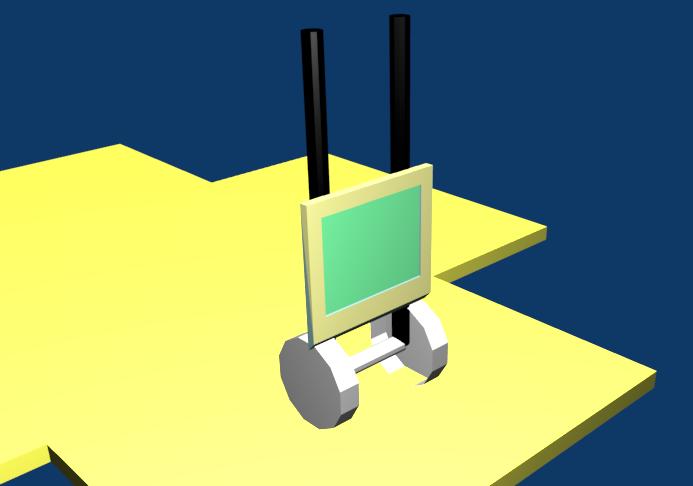
objeto 3D – mimoSa 0.0.0.0.1
mesmo ainda não exitindo fisicamente, o modelo projetado pelos dois foi fundamental para pensar plasticamente o objeto a ser criado durante as oficinas, o que ainda não havia sido feito ate entao. logo após, na cidade do Rio de Janeiro, foi construida a primeira versao fisica da maquina, em uma oficina pequena, com Giuliano Djahjah, Queops, Ricardo Ruiz e Uiran, com a ajuda de Romano (o inusitado). A oficina constituiu-se na selecao e compra do equipamento a ser utilizado na maquina, bem como a montagem da mesma. Teve duracao de dois dias. Foi constuida dentro de um carro de feira, e contava com um processador de 233 MHZ, 64 MB de memoria RAM, HD de 8 GB, trackball, monitor Flat Screen, No-Break e uma extensao eletrica de quase 30 metros. Ao final da montagem, a unica resposta que a maquina dava era o choque eletrico. Nada funcionava. Percebemos então, uma necessidade basica do equipamento: isolamento eletrico. a terceira versao da mimoSa ocorreu na cidade de Cachoeira, na regiao do reconcavo baiano, durante as oficinas de Metareciclagem, parte do primeiro encontro de conhecimentos livres da bahia, sergipe a alagoas, operacionado pelo departamento de cultura digital do ministerio da cultura do brasil. Dessa vez, a oficina aconteceu com cerca de 15 pessoas, e pela primeira vez a maquina funcionou como o esperado. Muitos foram os fatores para tal. Primeiramente, a oficina ocorreu durante três dias, tempo que se mostrou como minimo para a construcao coletiva da mesma. O hardware utilizado foi o mesmo que no rio de janeiro, porem dessa vez com o isolamento eletrico necessario. Como software, foi utilizado uma versao do ubuntu hoary [6] como sistema operacional e audacity [7] como aplicativo de gravacao de som. muitas pessoas colaboraram na construcao da maquina, tanto na montagem como na decoracao, e muitas foram as pessoas que se sentiam responsaveis por ela, o que facilitou, em muito, na fase seguinte da oficina: as intervencoes urbanas.
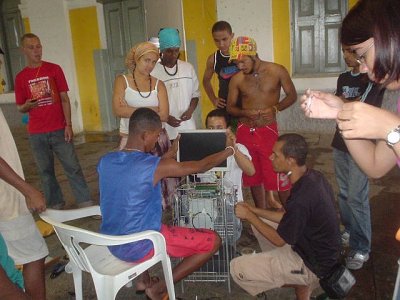 mimoSa e seus construtores na bahia
mimoSa e seus construtores na bahia
Vale notar que Cachoeira eh um rico local de construcao cultural, e, na cidade que possui “mais de 120 mil terreiros de candomble” eh notavel a producao escultural, musical e religiosa, alem de terreno frutifero de tradicoes afro-brasileiras. Assim que a maquina ficou pronta, sua primeira aparicao se deu em um espaco cultural destinado a criacao e disseminacao de samba de roda. o local onde era proibido filmagens e fotografias foi o escolhido para o batismo da maquina, sendo esse talvez o primeiro passo de sua metamaterializacao. De la, a mimoSa partiu em um cortejo, quase uma procissao, com cerca de 40 pessoas, que cantavam e gritavam “mimoSa... mimoSa” ou “venham conhecer, mimoSa chegou!”, rumo a praca principal da cidade, na beira do rio paraguaçu, onde gravou seus primeiros depoimentos, transmitiu (com baixo alcance) ao vivo radio em FM e tv em VHF e projetou videos produzidos durante o encontro de conhecimentos livres. Mesmo não estando ligados no hardware da mimoSa nem projetores nem sistema de som dos videos, todos sentiam aquelas projecoes como frutos da mimoSa, naquele momento já encarada como uma entidade. A proxima oficina para construcao da mimoSa aconteceu na vila de pescadores de Pipa, no Rio Grande do Norte. Ao contrario da oficina anterior, esta contou com a presenca de poucas pessoas (ricardo ruiz, tatiana wells, jose balbino e tininha llanos) mas foi fundamental para o, naquele momento, futuro da maquina. Pela primeira vez, nesta oficina, notou-se que a intencao de movimentar a maquina por entre diferentes cidades era prejudicial ao hardware da mimoSa: o HD dava sinais de desgaste profundo (foi trocado no comeco da oficina) e a CPU tambem não resistiu ao transporte, e foi substituida por uma CPU MMX com processamento de 300 MHZ. A nova versao da maquina levava em conta sua atual localizacao praiana e contou com madeiras de barco para seu isolamento e um guarda-sol para a protecao contra o forte luz diaria da regiao.
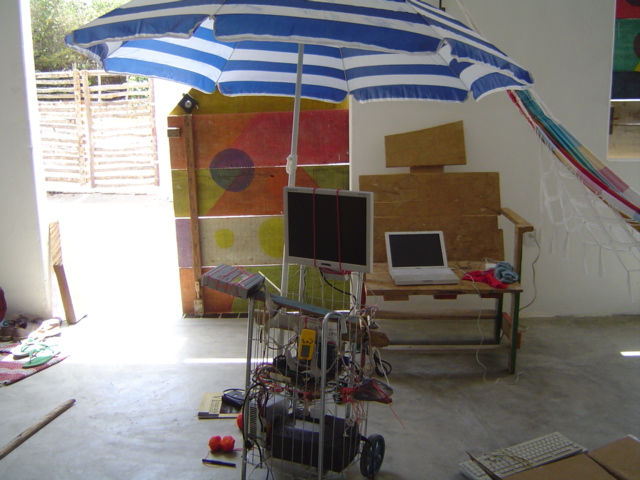
versao praiana da maquina
Mesmo não saindo as ruas, a oficina foi o que possibilitou um contato maior entre Balbino e Tininha com a montagem da maquina. Os dois seriam, a partir de entao, responsaveis por construir uma outra maquina na cidade de Salvador, capital Bahiana. A fase seguinte de construcao da mimoSa, em Salvador, foi durante o festival matutai, paralelo ao Forum Social Mundial, em janeiro de 2006. Desta vez, mimoSa foi montada após tres dias de discussoes sobre arte, ativismo, comunicacao independente, radios livres e genero. No ultimo dia de festival, as oficinas se realizaram, juntamente com apresentacoes de bandas e o programa de radio cidadao comum. projecoes em modo texto, streaming de audio e festejos fizeram parte dessa oficina. Ao final, a maquina estava montada, mas não conseguia funcionar. Sua placa-mae e o processador haviam queimado. Mesmo sem funcionar, a maquina se fez presente como um ente querido e doente.
a versao construida durante o festival matutai
A oficina de Salvador marcou um ponto importante na historia da mimoSa: o trabalho foi apresentado na capa do newsletter do renomado site sobre net arte rizhome.org. Ao mesmo tempo, mostrou que muitas pecas do harware estavam queimando, o que impossibilitava o transporte continuo do seu corpo fisico: a mimoSa precisaria de uma solucao urgente para continuar existindo. De volta a vila de Pipa, mais uma oficina, dentro do telecentro publico do local, desta vez com um numero reduzido de pessoas participando mas com grande impacto nas criancas do local. Esta oficina marcou a morte e o renascimento da mimoSa. Pela terceira vez consecutiva uma CPU foi queimada, os HDs não mais funcionavam, assim como os pentes de memoria RAM. Foi decretado, em um post do blog da mimoSa, sua morte. A mimoSa não poderia mais viver como até o momento. Chegou-se a uma solucao: a mimoSa deveria ser, a partir de então, clonada em diferentes cidades. Com as características de cada local, isso permitiria sua flexibilizacao e seu maior alcance. a licenca creative commons permitia. arte faca voce mesmo. as primeiras propostas de cidades a clonarem as oficinas mimoSa foram são paulo, salvador e curitiba. o que sobrou do premio foi dividido entre são paulo e salvador. Porem, outros clones surgiram, como aconteceu em aracaju, no estado do sergipe, durante o festival de cinema curta-se. em se tratando de hardware, as oficinas de aracaju foram otimas para testar a nova cpu que existira na mimoSa de salvador. Trata-se da melhor maquina que já funcionou como mimoSa ate entao: uma cpu onboard com saidas s-video, video rca, video vga, ehernet, faxmodem, saidas de audio P2, entradas linha e microfone, paralela, serial, ps2 e usb, rodando em um processador de 400 MHZ com 96 Mb de memoria RAM. O leitor de DVD chegou a funcionar por alguns instantes. A montagem aconteceu durante cinco tardes, com duas fases distintas: na primeira, foi montada em uma armacao de arame (antigos armarios) , suas rodas eram feitas com rolos de filme de 16mm, e trabalhava, milagrosamente, com um monitor de video cga fosforo verde de 12 polegadas, de um computador pessoal TK-3000 de fabricacao de 1985. A estrutura ainda foi enfeitada com ventoinhas, display lcd (onde lia-se “JAH”), tran'cinhas, filmes. Um dos artistas(publico) melhor sintetizou o sentimento de todos: “nao há como não gostar dela, voce ajudou a montar a bichinha”. Na segunda fase, quando o monitor de fosforo verde não mais aguentou funcionar, foi preciso substitui-lo por um monitor de 15” VGA, que a fragil estrutura de arame não mais aguentava, tao pouco as rodas de rolo de filme. rapidamente a estrutura da maquina transformou-se em uma cadeira com rodas sem as almofadas, que permitiram, por coincidencia, encaixe perfeito para monitor e rolos de filme, e a cpu e hd ficaram suspensos por um sistema de arames e fios eletricos – um melhor sistema de amortecimentos que permitou uma mobilidade nunca dantes vista para a maquina-amiga. Importante notar que, depois de muitas pessoas se identificarem com a mimosa durante e depois das oficinas, um transeunte, sem contato com as oficinas, ao ver o conjunto de fios e placas na rua, esperando transporte, rolos de fita e trancinhas, pergunta: “eh para jogar fora?”.
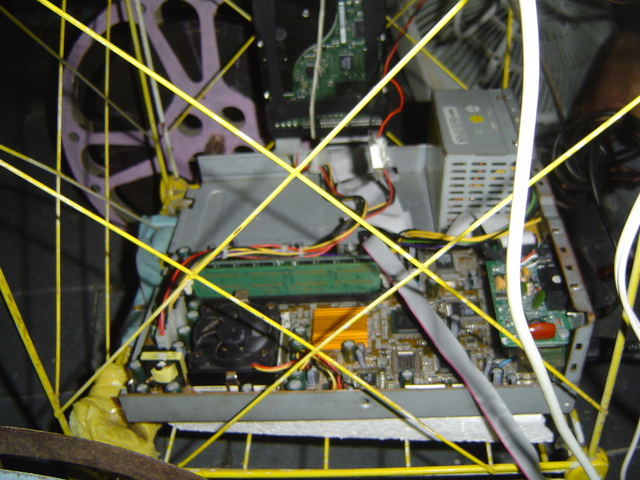 primeira versao montada em aracaju
primeira versao montada em aracaju
Foi tranportada ate um shopping center onde eram exibidos os longa-metragens da mostra, assutou-se com propagandas, impressionou-se com lojas de eletrodomesticos, foi obrigada a ser desligada por segurancas, entrevistou gerentes, publicos, participantes da mostra, construtores da maquina. Em outro dia, viajou de onibus ate a cidade de são cristovao, quarta cidade mais antiga do brasil, onde não participou em corpo fisico (a chuva impossibilitou que fosse ligada e transportada), porem foi levada junto com todos e esperou, sendo carinhosamente vigiada e cuidada por cada um que a conhecia, em um bar da praca principal da cidade. mas, da mesma forma, gravou, atraves de dispositivos remotos, audios e videos com dancas, apresentacoes folcloricas, conversas, programas de radio. gravadores de audio digitais e cameras de videos digitais, mostraram-se partes integrantes da mimosa, mesmo sem estar, literalmente, conectada a ela.
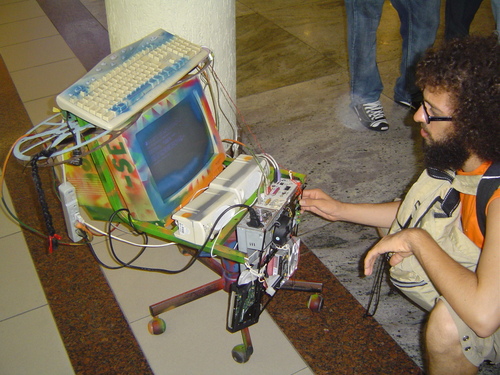 a versao final de aracaju
a versao final de aracaju
A nova CPU, jah separada de suas outras partes (que prometem voltar a funcionar em aracaju), voltou para Salvador, onde foi apresentada ao seu novo corpo fisico: um carrinho que vende café, com formato de trio eletrico, tipico da cidade de Salvador, com monitor de 9” e, como refletido, “com possibilidade de ainda fazer um dinheirinho”. Sua primeira aparição foi durante o Upgrade Salvador [8] e continuou com as versões subsequentes do festival.
- revolvendo o objeto artistico e o publico-artista
A cada nova oficina, mimoSa agrega novas pessoas responsáveis pela sua construcao que, acima de tudo, percebem novos usos para tecnologias e se percebem como artistas. Porem, não soh como artistas: se percebem tambem como tecnicos, como engenheiros, como radialistas, jornalistas, fotografos, interventores. Participam da construçao de um objeto multifacetado, construido por diversas pessoas em diferentes lugares. Esta fragmentacao, por sua vez, eh benefica ao objeto, pois salienta a diversidade e a colaboracao como ferramentas indispensaveis para a construcao coletiva, para a producao de objetos culturais. Repensam nocao de autoria, de obra de arte, de computador, de sistemas operacionais. Começam, partir de entao, a descobrir objetos. Objetos para pesquisa e experimentação, para a recombinacao, para o trabalho coletivo e individual, para construção do objeto. As pessoas assumem diferentes funcoes dependendo do momento (oficinas, dias, horas, tarefas), combinadas previamente ou não. A experiência coletiva respeita cada indivíduo, e trabalha-se todos. Todos, oficineiros, artistas, publico, são colocados no mesmo patamar: experimentadores. Como os cientistas. Em espacos de aprendizado coletivo, tanto cultural como tecnico e social. Dessa forma, publico, artista, objeto de arte, funcao, utilidade, estetica, plastica e tecninca se fundem. Nessa fusao, a pessoa se identifica como ser, capaz de criar e alterar espacos e que, bastando, para isso, uma pratica amigavel de apropriacao das tecnicas. hardware livre. e garfo e faca são hardwares livres. caso contrario, corremos o serio risco de enveredar pelo mercado da arte “careta multimidia”, como diria o programa de radio recifenho Queops Negao.
- e agora?
Outras versões apareceram desde que este texto foi escrito. Duas em São Paulo, uma em Curitiba, Belém (PA), Porto Alegre (RS), Farkadonna, (Grécia) e mais uma vez em Salvador. Outras estão planejadas para aocntecer em Santarém (PA) e Manchester (UK). mimoSa prepara-se para possibilitar, cada vez mais, que pessoas tomem consciencia de seu direito a expressao, que entendam e subvertam os usos da tecnologia, que percebam-se como artistas, criativos, capazes de fazer ouvir suas historias, opinioes, e poderem participar de debates politicos, tecnologicos, sociais, midiaticos e culturais, criando seus proprios espacos de atuacao, criando voz, pernas e bracos com a pseudo-sucata.
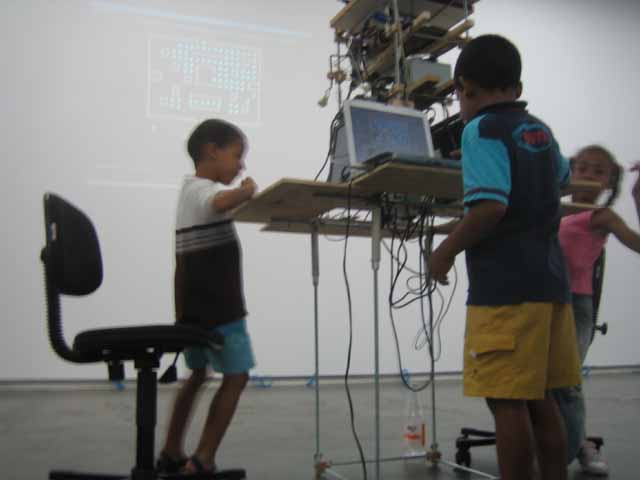 oficina nomade etienne, mais mimoSas
oficina nomade etienne, mais mimoSas
e saberemos, depois de completado seu tempo de vida determinado de 1GB de dados, qual o futuro da mimoSa. para saber as ultimas novidades sobre mimoSa, acesse http://www.turbulence.org/Works/mimoSa∞
- [1] http://www.ambriente.com/∞ [2] http://www.neurotransmitter.fm∞ [3] http://murmurtoronto.ca/∞ [4] http://www.metareciclagem.org∞ [5] http://www.blender.org∞ [6] http://www.ubuntu.com∞ [7] http://audacity.sourceforge.net/∞ [8] http://www.midiatatica.org/upgrade∞

objeto 3D – mimoSa 0.0.0.0.1 Even those it not existed fisically, the model projected by the two of them were fundamental to think plastically about the object, to be created during the workshops, that hasn't been done so far. Just after that, in Rio de Janeiro, was constructed the first physical version of the machine at a small workshop, with Giuliano Djahjah, Quéops Negão, Ruiz and Uirã, with the help of Romano. The workshop was divided in the selecting and buying the equipment that was going to be used at the machine, as much as assembling it. It had the duration of two days. It was construct inside a market trolley and it counted with a 233 MHz processor, 64 MB RAM memory, 8 GB of hard disk, trackball, flat screen monitor, no-break and a 30 meter electric extension. At the end of the workshop the only answer the machine gave was electric shock. Nothing worked. We realized there a basic necessity of the equipment: electric isolation. The third version of mimoSa happend at the city of Cachoeira, on Bahia's reconcavo, durint the metarecycling workshops, part of the 1st Free Knowledge Meeting of Bahia, Sergipe and Alagoas, realized by the Digital Culture Dep. of Brazilian Ministery of Culture. This time the workshop happened with around 15 people, and for the first time the machine worked as expected. Many were the reasons for that. Firstly, the workshop happened durint 3 days, what we discovered to be the minimun time to the collective construction. The hardware used was the same as in Rio de Janeiro, but this time with the necessary electric isolation. For software we used Hoary Ubuntu [6] as the operational system and Audacity [7] as the audio recording program. Many people collaborated on the construction of the machine, on its assembly as much as decoration, and many were the people that felt responsible by it, what made easy the next phase of the workshop: the urban interventions. It is worth noticing that Cachoeira is a rich place of cultural construction, and in the city that has "more than 120.000 terreiros de Candomblé" it is notable the sculptural, musical and religious production, besides being a fertile place for afro-brazilian traditions. As soon as the machine was ready, its first appereance was at the cultural space dedicated to the creation and dissemination of Samba de Roda. That place, that was prohibited filming and photography, was choosen for the machine's baptism, being this perhaps the first step of its materialization. From there, mimoSa set on a cortejo, almost a procession, with around 40 people that sung and shout "mimoSa... mimoSa" or "Came and meet mimoSa, she has arrived!", on the way to the main square of the city, at the borders of Paraguaçu River, where it recorded its first testimonies, transmited (in low potency) FM radio and VHF TV. And projected videos made during the Free Knowledge Meeting. Even though the projector and the soudnsystem of the videos was not part of mimoSa's hardware, everyone felt that projections fruits of mimoSa. At that moment, already felt as an entity.
 mimoSa e seus construtores na bahiaThe next mimoSa workshop happened at the fishermen village of Pipa, RN. On the contrary of the previous workshops, it counted with a few people: Ruiz, Tatiana, Balbino, Tininha and Eddy Polo. But it was fundamental to what, at that moment, was the future of the machine. For the first time on these workshops, it was noted that that intention of moving the machine by different cities was harmful for mimoSa's hardware: the hard disk was giving deep signals of weariness (it was changed at the begining of the workshop) and the motherboard also did not resisted transportation, and it was substituted by an MMX motherboard, with 300 MHz processor. The new version of the machine took in consideration its current seaside localization, and counted with used wood from ships used as isolator and a parasol for its protection against the strong daylight of the region.
mimoSa e seus construtores na bahiaThe next mimoSa workshop happened at the fishermen village of Pipa, RN. On the contrary of the previous workshops, it counted with a few people: Ruiz, Tatiana, Balbino, Tininha and Eddy Polo. But it was fundamental to what, at that moment, was the future of the machine. For the first time on these workshops, it was noted that that intention of moving the machine by different cities was harmful for mimoSa's hardware: the hard disk was giving deep signals of weariness (it was changed at the begining of the workshop) and the motherboard also did not resisted transportation, and it was substituted by an MMX motherboard, with 300 MHz processor. The new version of the machine took in consideration its current seaside localization, and counted with used wood from ships used as isolator and a parasol for its protection against the strong daylight of the region. 
versao praiana da maquina Although it didn't go on the streets, this workshop was the one that make possible a bigger contact of Balbino and Tininha with the assembly of the machine. The two would be, from that moment on, responsible for construction another machine at the city of Salvador, Bahia's capital. The next phase of mimoSa construction in Salvador was during Matutaí Festival, paralel to the World Social Forum in January, 2006. This time, mimoSa was assembled after 3 days of discussions on art, activism, independent communication, free radio and gender. At the last day of the festival, the workshop happened at the same time and space of bands and the rádio cidadao comum program, ASCII projection, audio streaming and parties were part of this workshop. At the end, the machine was assembled, but could not work. Its motherboard and processor were burnt. Without working, mimoSa physicall body was present and taken as sick relative.
a versao construida durante o festival matutaiThe workshop in Salvador marked an important moment on mimoSa's history: the work was presented at rizhome's net art newsletter. At the same time, we realized that too many important pieces of hardware have stopped working, what made impossible the continuous transportation of its physical body: mimoSa needed an urgent solution to continue living. Back to the village of Pipa, one more workshop, inside the public telecenter. This time, with a small number of people, but with a great impact on local children. This workshop marked the death and renaissance of mimoSa. By the third consecutive time, a motherboard was burnt. The hard disk did not work, as much as the RAM memory cards. It was posted on mimoSa's blog it's death. mimoSa could not exist as has existed so far. The solution we came up with at that workshop was: mimoSa should have, from that moment onwards, to be cloned at different cities. This would permit that mimoSa aquired local caracteristics, flexibilization and wider spread. Its Creative Commons licence allowed it. Do it yourself art. The first proposals of cities to clone mimoSa's workshop came from São Paulo, Salvador and Curitiba. The spare money was divided between São Paulo and Salvador. But, other clones were also able to emerge. Like the one that happened at Aracaju, Sergipe, during the city's film festival Curta-se. Talking about hardware, Aracaju's workshop were excelent to test the new motherborad that would later be use in Salvador's mimoSa. it was the best mimoSa machine until now: an onboard motherboard with S Video, RCA, VGA, Ethernet, Faxmodem, P2Audio outputs, and two mixer imputs, USB, PS2 paralllel serial and a 400 MHZ processor with 96 MB memory. The DVD reader worked for some seconds, the contruction happened during 5 afternoons, with two distinct phases: on the first it made of a wire structure (old shelters), its wheels were made with 16 mm film rolls and miracously worked with a green phosporous CDA video monitor, iwth 12" inch, that once belonged to a personal TK-3000 manufactured in 1985. The structure was adorned with computer's little fans, LCD display (where we could read "JAH"), small narrow braids, films. One of the artists(public) best syntethized the feeling's of the workshops: "there is no way to dislike her, you have helped to build the birdy"...; on the second phase, when the green phosporous monitor could not handle any more, was necessary to change it by a 15" inch VGA. But the fragile wire structure this time, could not handle the new monitor. Quickly, the machine structure became an office wheel chair without upholstered that permited, by coincidence, a perfect fit for the monitor and the film rolls. The motherboard and hard disk were suspended by wires - a shocking-absorbing system that permited a mobility never seen before for the friendly machine. It is important to note that, after lots of people identifying theselves with mimoSa during and after the workshops, a passer-by, without contact with the workshop, seeing the mixture of computer parts, wires, films and braids on the street, asks: " is it to throw away?".
 primeira versao montada em aracajuAracaju's mimoSa was transported to a shopping center where the films from the festival were being exibithed, and it scared herself with adversisements, got impressed with eletrodomestic shops, was obliged to be turned off by security guards, interviwed managers, public and participants of the festival and the local constructors of the machine. On the subsequent day, travelled by bus to São Cristovão city the fourth oldest city in Brazil, where the rain prohibited it from being turned on to walk around, but waited in a bar on the city's main park, where it was gently taken care of by each one that knew her. In despite of that, it recorded through remote devices, audio and video of folk dances, talks, radio programs. MP3 and MPEG digital records showed as integrated parts of mimoSa even thought not being literally connected to her.
primeira versao montada em aracajuAracaju's mimoSa was transported to a shopping center where the films from the festival were being exibithed, and it scared herself with adversisements, got impressed with eletrodomestic shops, was obliged to be turned off by security guards, interviwed managers, public and participants of the festival and the local constructors of the machine. On the subsequent day, travelled by bus to São Cristovão city the fourth oldest city in Brazil, where the rain prohibited it from being turned on to walk around, but waited in a bar on the city's main park, where it was gently taken care of by each one that knew her. In despite of that, it recorded through remote devices, audio and video of folk dances, talks, radio programs. MP3 and MPEG digital records showed as integrated parts of mimoSa even thought not being literally connected to her.  a versao final de aracajuThe new motherboard divided from the other parts, came back to Salvador, it was presented to its new physical body: a coffee seeling car with a format of a trio elétrico, very typical to the city, with a 9" inch monitor and with good chances of "earning a change". Its first appearance was during Upgrade!Salvador [8], and continued during subsequent festivals. Revolving the artistic object and public artistAt each new workshop, mimoSa aggregates new people that are able to feel responsible for the construction, for the new uses of the technologies and their own perception as artists. But, not only as artists: they also perceive themselves as technicians, engineers, radialists, jornalists, photographers, actors. They participate on the construction of a multifaced object, constructed by many people, in different localities. This fragmentation, on the other side, is benefical to the object, because it highlights the diversity and the collaboration as necessary tool to the collective construction, to the production of cultural objects. They rethink their notion of authorship, of a work of art, of a computer, of an operational system, beginning to rediscover objects. Objects to research and experiment, to recombine, to the collective and individual work. To the construction of the object, people assume different functions on different moments (workshops, days, tasks) that could or could not be established before. The collective experience respects each individual and works together with everyone. All, people that are giving workshops, artists, public, are put on the same level: experimenters. As scientists. In collective leraning spaces as much as cultural, technical and social. This way, public, artist, object of art, function, utility, aestethic, plasticity and technique fuse thenselves. At this fusion, the person identifies itself as being able of creating and alter spaces and that, to be achieved, it is only necessary a friendly practice of technical appropriation. Free hardware. Spoon and fork are free hardware. On the contrary, we have a serious risk of go to the direction of the multimedia artmarket, or, careta multimídia, as it is already said on Quéops Negão Radio Program. and now?Other versions appeared since this text was written. 2 in São Paulo (SP), 1 in Curitiba (PR), Belém (PA), Porto Alegre (RS), Farkadonna, (Greece) and one more time in Salvador. Next ones are planned to happen in Santarém (PA) and Manchester (UK). mimoSa prepares to make possible that more people acknowledge their expression rights, that understand and subvert the uses of technology, that perceive thenselves as artists, as creative selves, able to listen to each other stories, opinions, being able to participate on political, technological, social, mediatic and cultural debates, creating their own action spaces, creating voices, arms and legs with the so-called garbage.
a versao final de aracajuThe new motherboard divided from the other parts, came back to Salvador, it was presented to its new physical body: a coffee seeling car with a format of a trio elétrico, very typical to the city, with a 9" inch monitor and with good chances of "earning a change". Its first appearance was during Upgrade!Salvador [8], and continued during subsequent festivals. Revolving the artistic object and public artistAt each new workshop, mimoSa aggregates new people that are able to feel responsible for the construction, for the new uses of the technologies and their own perception as artists. But, not only as artists: they also perceive themselves as technicians, engineers, radialists, jornalists, photographers, actors. They participate on the construction of a multifaced object, constructed by many people, in different localities. This fragmentation, on the other side, is benefical to the object, because it highlights the diversity and the collaboration as necessary tool to the collective construction, to the production of cultural objects. They rethink their notion of authorship, of a work of art, of a computer, of an operational system, beginning to rediscover objects. Objects to research and experiment, to recombine, to the collective and individual work. To the construction of the object, people assume different functions on different moments (workshops, days, tasks) that could or could not be established before. The collective experience respects each individual and works together with everyone. All, people that are giving workshops, artists, public, are put on the same level: experimenters. As scientists. In collective leraning spaces as much as cultural, technical and social. This way, public, artist, object of art, function, utility, aestethic, plasticity and technique fuse thenselves. At this fusion, the person identifies itself as being able of creating and alter spaces and that, to be achieved, it is only necessary a friendly practice of technical appropriation. Free hardware. Spoon and fork are free hardware. On the contrary, we have a serious risk of go to the direction of the multimedia artmarket, or, careta multimídia, as it is already said on Quéops Negão Radio Program. and now?Other versions appeared since this text was written. 2 in São Paulo (SP), 1 in Curitiba (PR), Belém (PA), Porto Alegre (RS), Farkadonna, (Greece) and one more time in Salvador. Next ones are planned to happen in Santarém (PA) and Manchester (UK). mimoSa prepares to make possible that more people acknowledge their expression rights, that understand and subvert the uses of technology, that perceive thenselves as artists, as creative selves, able to listen to each other stories, opinions, being able to participate on political, technological, social, mediatic and cultural debates, creating their own action spaces, creating voices, arms and legs with the so-called garbage.  oficina nomade etienne, mais mimoSas And we will know, after its time life of 1 GB is completed, what is the future of mimoSa. To know more about mimoSa, keep checking the blog @ http://www.turbulence.org/Works/mimoSa∞
oficina nomade etienne, mais mimoSas And we will know, after its time life of 1 GB is completed, what is the future of mimoSa. To know more about mimoSa, keep checking the blog @ http://www.turbulence.org/Works/mimoSa∞




